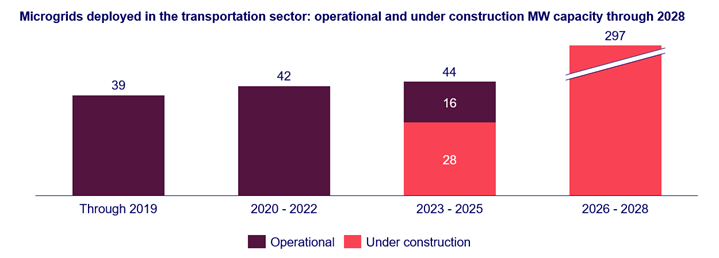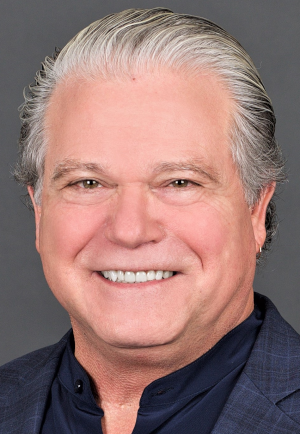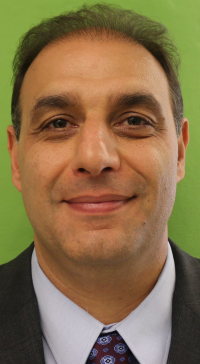Agenda |
|
Tuesday, December 5, 2023
8:00 - 9:00 am Registration and Welcome Coffee
9:00 - 9:30 am
Electrification and Decarbonization Hand in Hand
The Brookville Smart Bus Depot microgrid started operating in October 2022 and the Equipment Maintenance and Transit Operations Center (EMTOC) microgrid is under construction. What is so important about these two projects? They are game changers. Both are powering zero emissions vehicles (transit buses) without increasing the power from the grid. With Brookville, Montgomery County and AlphaStruxure proved that the grid is NOT required to be upgraded for heavy duty EV charging. This is counter to the mainstream messaging about grid improvements to electrify transportation.
With each microgrid at these two transit hubs, not only are the sites electrifying they are also decarbonizing with the use of the microgrids. Each microgrid has a plan to move from ~60% decarbonization now to 100% decarbonization by 2030.
This session will discuss the keys to the direction taken to enable these two microgrids, the essential outcomes provided, and the applicability of these two sites to the broader transit and commercial delivery vehicle space.
9:30 - 10:00 am
The Brookville Smart Bus Depot microgrid started operating in October 2022 and the Equipment Maintenance and Transit Operations Center (EMTOC) microgrid is under construction. What is so important about these two projects? They are game changers. Both are powering zero emissions vehicles (transit buses) without increasing the power from the grid. With Brookville, Montgomery County and AlphaStruxure proved that the grid is NOT required to be upgraded for heavy duty EV charging. This is counter to the mainstream messaging about grid improvements to electrify transportation.
With each microgrid at these two transit hubs, not only are the sites electrifying they are also decarbonizing with the use of the microgrids. Each microgrid has a plan to move from ~60% decarbonization now to 100% decarbonization by 2030.
This session will discuss the keys to the direction taken to enable these two microgrids, the essential outcomes provided, and the applicability of these two sites to the broader transit and commercial delivery vehicle space.
9:30 - 10:00 am
Providing Customers the Economic Benefits of their Microgrids: The Challenges and Solutions
Since microgrids have become more than standby power, providers have been able to easily show the environmental benefits but have struggled to provide customers with what their financial results will be. We all have heard very impressive microgrid presentations at many conferences. Yet, when questions arise about what their Levelized Cost of Energy (LCOE) was, or Return on Investments (ROI) are, answers commonly given have been; "that was not the microgrid's objective" or "it was really a demonstration project". Yet, microgrid growth won't truly take-off until providers can show favorable financial returns in addition to their environmental impact.
Over the years, Innovus Power has performed microgrid design and financial models on hundreds of applications. Through this experience, we can share key hurdles that commonly impede a provider's capability to financially evaluate what a customer is looking for. Some of these challenges are in the following areas:
10:00 - 10:30 am
Since microgrids have become more than standby power, providers have been able to easily show the environmental benefits but have struggled to provide customers with what their financial results will be. We all have heard very impressive microgrid presentations at many conferences. Yet, when questions arise about what their Levelized Cost of Energy (LCOE) was, or Return on Investments (ROI) are, answers commonly given have been; "that was not the microgrid's objective" or "it was really a demonstration project". Yet, microgrid growth won't truly take-off until providers can show favorable financial returns in addition to their environmental impact.
Over the years, Innovus Power has performed microgrid design and financial models on hundreds of applications. Through this experience, we can share key hurdles that commonly impede a provider's capability to financially evaluate what a customer is looking for. Some of these challenges are in the following areas:
- Project objectives
- Project roles and responsibility allocations
- Microgrid system design variation
- Performance characteristics of wide-ranging components
- Range and volatility of key system cost drivers
- Key unknown and hidden costs
10:00 - 10:30 am
Benefits of Microgrids in Municipal and Coop Power Suppliers
This session will discuss the benefits of building microgrids around a municipality or a member of a coop. After examining various forms of microgrids that can be built, we will quantify transmission and energy savings, and discuss reliability gains. The speaker will also argue that the economic gains are more than transmission and energy savings since there are short-term employment gains during the construction of the microgrid. There is also long-term employment due to O&M as well as property tax/lease income from the microgrid, all of which currently are being spent on a large power plant somewhere else in most cases.
10:30 - 11:00 am
Networking Coffee Break
11:00 - 12:15 pm
This session will discuss the benefits of building microgrids around a municipality or a member of a coop. After examining various forms of microgrids that can be built, we will quantify transmission and energy savings, and discuss reliability gains. The speaker will also argue that the economic gains are more than transmission and energy savings since there are short-term employment gains during the construction of the microgrid. There is also long-term employment due to O&M as well as property tax/lease income from the microgrid, all of which currently are being spent on a large power plant somewhere else in most cases.
10:30 - 11:00 am
Networking Coffee Break
11:00 - 12:15 pm
Utility Microgrid Case Studies
Non-wires alternatives such as microgrids can play an effective role in utilities' toolbox for delivering power quality and reliability to high-value customers. They can also be an important strategy for serving remote areas where load growth is straining distribution network infrastructure. Additionally, microgrids can be a key resiliency and outage restoration option for areas affected adversely by disruptions related to extreme weather events. Furthermore, microgrids can help advance a decarbonized energy grid at the local level, where residents can become more involved in the community co-ownership and greening of their electricity service.
For these reasons and more, utilities are looking at how microgrids can play a role in their service offerings going forward. This session will look at case studies where electric utilities in the U.S. have implemented microgrids, with discussion of enabling technologies, business models, and key takeaways to date. The goal is to help provide insight and guidance as to how other utilities can utilize microgrids in their future network planning.
12:15 - 1:15 pm
Lunch Break
1:15 - 2:45 pm
Non-wires alternatives such as microgrids can play an effective role in utilities' toolbox for delivering power quality and reliability to high-value customers. They can also be an important strategy for serving remote areas where load growth is straining distribution network infrastructure. Additionally, microgrids can be a key resiliency and outage restoration option for areas affected adversely by disruptions related to extreme weather events. Furthermore, microgrids can help advance a decarbonized energy grid at the local level, where residents can become more involved in the community co-ownership and greening of their electricity service.
For these reasons and more, utilities are looking at how microgrids can play a role in their service offerings going forward. This session will look at case studies where electric utilities in the U.S. have implemented microgrids, with discussion of enabling technologies, business models, and key takeaways to date. The goal is to help provide insight and guidance as to how other utilities can utilize microgrids in their future network planning.
12:15 - 1:15 pm
Lunch Break
1:15 - 2:45 pm
Community and Multi-User Microgrids for Resilience: Implementation Challenges and Perspectives from Puerto Rico and Washington
Historically, the majority of microgrids have been developed as single-customer assets behind the meter (hospitals, Department of Defense installations, etc.) or by utilities driving the development process. Increasingly, communities are seeking to lead the development of multi-user or multi-property microgrids to meet their own goals for resilience, energy equity and independence, and decarbonization. Without utility partners, the complex business models, regulatory and technical challenges (e.g., interconnection agreements, operating agreements, and financing structures) may prevent these projects from moving forward. This panel will discuss the value proposition of multi-user microgrids, the challenges of developing them, and progress in addressing those challenges. Finally, two case studies from communities moving forward with multi-user microgrids will be presented.
Key Takeaways:

2:45 - 3:15 pm
Networking Coffee Break
3:15 - 4:00 pm
Historically, the majority of microgrids have been developed as single-customer assets behind the meter (hospitals, Department of Defense installations, etc.) or by utilities driving the development process. Increasingly, communities are seeking to lead the development of multi-user or multi-property microgrids to meet their own goals for resilience, energy equity and independence, and decarbonization. Without utility partners, the complex business models, regulatory and technical challenges (e.g., interconnection agreements, operating agreements, and financing structures) may prevent these projects from moving forward. This panel will discuss the value proposition of multi-user microgrids, the challenges of developing them, and progress in addressing those challenges. Finally, two case studies from communities moving forward with multi-user microgrids will be presented.
Key Takeaways:
- Value proposition of multi-user microgrids for communities, utilities, and end-use customers
- Key business model, regulatory, and technical obstacles that stakeholders face when seeking to develop multi-user microgrids
- Considerations prior to developing a multi-user microgrid (e.g., who benefits, who pays, and who owns and operates)
- Examples of how these obstacles have been addressed in specific microgrid projects
- Recent developments to support communities in addressing those obstacles on future projects
- Type of change still needed to enable the widespread proliferation of multi-customer (Community) microgrids

2:45 - 3:15 pm
Networking Coffee Break
3:15 - 4:00 pm
Electrifying Transportation: Microgrid Solutions and Emerging Trends in a Changing Energy Landscape
Grid insecurity is a mounting concern as the climate and energy crises intensify. Furthermore, It is expected that electricity demand will surge by more than 35% by 2050, primarily driven by the rapid adoption of electric vehicles (EVs) and transportation electrification. To alleviate the strain on distribution networks, utilities are exploring non-wire alternative solutions to avoid lengthy and costly infrastructure upgrades. Furthermore, companies are increasingly driven by their ESG goals to electrify their fleets. Nevertheless, this transition presents challenges, particularly regarding costs. Microgrids are a shortcut emerging as a promising solution to address these challenges while offering added resilience.
Key Takeaways:
4:00 - 4:30 pm
Grid insecurity is a mounting concern as the climate and energy crises intensify. Furthermore, It is expected that electricity demand will surge by more than 35% by 2050, primarily driven by the rapid adoption of electric vehicles (EVs) and transportation electrification. To alleviate the strain on distribution networks, utilities are exploring non-wire alternative solutions to avoid lengthy and costly infrastructure upgrades. Furthermore, companies are increasingly driven by their ESG goals to electrify their fleets. Nevertheless, this transition presents challenges, particularly regarding costs. Microgrids are a shortcut emerging as a promising solution to address these challenges while offering added resilience.
Key Takeaways:
- Interest in microgrid adoption has surged across transportation sectors since 2015: Over 11 microgrids deployed and an additional 25 projects announced in the pipelines of utilities and solution providers through 2028, spanning e-fleets, e-bus transits, ports, and airports.

- Microgrid-as-a-Service (MaaS) offerings as a solution to mitigate upfront costs: The interest of various investors in MaaS for e-mobility gaining a market share exceeding 38%.
- Added business opportunities for fleet operators: resilience-added benefits ensuring fleet charging during grid disturbances, cost avoidance for grid upgrades, demand charge mitigation, and the modularity of advanced microgrids, allowing expansion as the fleet electrification expands over time. Modular solutions can reduce the project lifecycle by up to 40%.
4:00 - 4:30 pm
Remote Grids: A Safe and Cost-Effective Alternative to Rural Distribution Lines
In the U.S., 5.5 million miles of distribution lines stretch across the nation, with a significant portion traversing forested regions. As the grid ages, these distribution lines increasingly pose a liability for utilities, becoming vulnerable to storms and powerful winds, causing millions of power outages annually. In the western part of the country, these lines have also been known to ignite devastating wildfires. In this session, BoxPower's Director of Applications Engineering Alexander Asante will be discussing three case studies, namely the Sagehen Field Station Remote Grid with Liberty Utilities, the Briceburg Remote Grid with PG&E, and the Pyramid Lake Remote Grid with Southern California Edison. These examples demonstrate how standalone solar-based power systems helped these IOUs reduce cost, mitigate wildfire risk, and improve energy resiliency for a variety of ratepayers.
Key Takeaways:
4:30 - 5:00 pm
In the U.S., 5.5 million miles of distribution lines stretch across the nation, with a significant portion traversing forested regions. As the grid ages, these distribution lines increasingly pose a liability for utilities, becoming vulnerable to storms and powerful winds, causing millions of power outages annually. In the western part of the country, these lines have also been known to ignite devastating wildfires. In this session, BoxPower's Director of Applications Engineering Alexander Asante will be discussing three case studies, namely the Sagehen Field Station Remote Grid with Liberty Utilities, the Briceburg Remote Grid with PG&E, and the Pyramid Lake Remote Grid with Southern California Edison. These examples demonstrate how standalone solar-based power systems helped these IOUs reduce cost, mitigate wildfire risk, and improve energy resiliency for a variety of ratepayers.
Key Takeaways:
- How remote grids can reduce wildfire risk for energy providers while increasing the reliability of their grid
- How solar remote grids have cost, resiliency, and safety benefits for both wildfire-prone and aging infrastructure locations
- How the increasing threat of natural disasters will test grid resilience, especially in rural and remote areas
4:30 - 5:00 pm
A Case for Renewable Energy Microgrids
As EV adoption swells, critical charging infrastructure is subject to growing pressure on a number of fronts: 1) increased aggregate power and energy demands; 2) network coverage requiring deployments at the "grid-edge" with limited excess distribution capacity and; 3) decreased user tolerance for imperfect charging sessions. This session will present a case for renewable microgrids as a solution to ameliorate these challenges. We will describe how DERs can provide additional capacity during peak usage, and present a case for renewable-backed DCFC stations to manage DERs, EVSEs and fleets. A unique combination of IoT, AI and operations optimizations enable these microgrids and deliver affiliated benefits to utilities, site operators and end-users.
5:00 - 6:30 pm
Drink Reception
Wednesday, December 6, 2023
8:00 - 9:00 am
Welcome Coffee
9:00 - 9:30 am
As EV adoption swells, critical charging infrastructure is subject to growing pressure on a number of fronts: 1) increased aggregate power and energy demands; 2) network coverage requiring deployments at the "grid-edge" with limited excess distribution capacity and; 3) decreased user tolerance for imperfect charging sessions. This session will present a case for renewable microgrids as a solution to ameliorate these challenges. We will describe how DERs can provide additional capacity during peak usage, and present a case for renewable-backed DCFC stations to manage DERs, EVSEs and fleets. A unique combination of IoT, AI and operations optimizations enable these microgrids and deliver affiliated benefits to utilities, site operators and end-users.
5:00 - 6:30 pm
Drink Reception
8:00 - 9:00 am
Welcome Coffee
9:00 - 9:30 am
A Novel DERMS + Transactive Energy Platform for Microgrid interoperability with the Bulk Power Grid
With increasing numbers of distributed energy resources (DERs), fast AC & DC EV chargers and net-zero homes/buildings within T&D power grids, aggregators can form virtual power plants (VPP) and Microgrids (MG) with numerous DER, EVSE (for V2G), smart flexible loads (e.g., smart thermostats, smart appliances and programable EV chargers) to interact with the bulk power systems' operators during peak-demand hours and contingency conditions. The cooperation between the power grid operators and VPP/MG owners/aggregators is mutually beneficial for both stake holders. The power grid operators could keep the lights on during peak-demand and contingency conditions for their customers, and the VPP/MG owners/aggregators could make money for their capital investments. In this presentation, we will demonstrate the simulations and optimal management of VPP and EVSE (for V2G and V1G) resources within two distribution feeders in north America, and the positive effects of DER and EVSE on the grids' voltage stability, transformers/cables congestion relief and the overall grid reliability.
9:30 - 10:00 am
With increasing numbers of distributed energy resources (DERs), fast AC & DC EV chargers and net-zero homes/buildings within T&D power grids, aggregators can form virtual power plants (VPP) and Microgrids (MG) with numerous DER, EVSE (for V2G), smart flexible loads (e.g., smart thermostats, smart appliances and programable EV chargers) to interact with the bulk power systems' operators during peak-demand hours and contingency conditions. The cooperation between the power grid operators and VPP/MG owners/aggregators is mutually beneficial for both stake holders. The power grid operators could keep the lights on during peak-demand and contingency conditions for their customers, and the VPP/MG owners/aggregators could make money for their capital investments. In this presentation, we will demonstrate the simulations and optimal management of VPP and EVSE (for V2G and V1G) resources within two distribution feeders in north America, and the positive effects of DER and EVSE on the grids' voltage stability, transformers/cables congestion relief and the overall grid reliability.
9:30 - 10:00 am
The End Game: Tapping Buildings as a Virtual Power Plant
To bolster the grid, buildings could play a pivotal role when transformed into a Virtual Power Plant (VPP) or a "New Utility," by forming a collective network of hundreds or even thousands of sites that harness the untapped potential of their assets, such as thermostats, electric vehicles, appliances, batteries, and solar arrays. With intelligent management of these resources, buildings can potentially and collectively offer a wide range of energy services, including capacity, energy provision and ancillary services, akin to those provided by traditional power plants.
This session will highlight the current role and market potential of small and medium commercial buildings in the energy landscape; the key challenges and barriers that hinder the integration of smaller buildings into energy management solutions; and the kinds of opportunities and changes necessary for making buildings as VPPs a reality.
10:00 - 10:30 am
To bolster the grid, buildings could play a pivotal role when transformed into a Virtual Power Plant (VPP) or a "New Utility," by forming a collective network of hundreds or even thousands of sites that harness the untapped potential of their assets, such as thermostats, electric vehicles, appliances, batteries, and solar arrays. With intelligent management of these resources, buildings can potentially and collectively offer a wide range of energy services, including capacity, energy provision and ancillary services, akin to those provided by traditional power plants.
This session will highlight the current role and market potential of small and medium commercial buildings in the energy landscape; the key challenges and barriers that hinder the integration of smaller buildings into energy management solutions; and the kinds of opportunities and changes necessary for making buildings as VPPs a reality.
- The role and market potential of small and medium commercial buildings in the energy landscape
- The key challenges and barriers that hinder the integration of smaller buildings into energy management solutions
- The kinds of technology, business and regulatory changes that are necessary to harness the potential of small and medium commercial buildings in energy management
- A vision for how buildings and their assets can be leveraged as Virtual Power Plants (VPPs) to create an aggregated network of sites that supports the grid, and the kinds of VPP components that can contribute to grid stability and reliability
10:00 - 10:30 am
Revolutionizing the Grid with Fast-Track Microgrids and VPP Flexible Capacity
Microgrids are becoming an increasingly important tool for commercial and industrial enterprises. By generating and storing power on-site, organizations are becoming more efficient, resilient and self-reliant, making them better able to withstand the impacts of volatile?energy costs and grid outages. Until now, each microgrid has been largely custom-engineered and incorporated different?software, hardware, and interface systems to meet the unique specifications for each build. This session discusses a simple, standardized, validated and scalable strategy for designing and accelerating the deployment of microgrids. When simple and repeatable microgrids are combined with VPPs - harnessing either the distributed energy resources (DERs) within a single microgrid and/or aggregating multiple microgrids - the larger grid benefits from a multiplier effect. Capturing capacity and delivering grid services this way reduces strain, boosts reliability, cuts costs, and advances the clean energy transition by furthering sustainability.
10:30 - 11:00 am
Networking Coffee Break
11:00 - 11:45 am
Microgrids are becoming an increasingly important tool for commercial and industrial enterprises. By generating and storing power on-site, organizations are becoming more efficient, resilient and self-reliant, making them better able to withstand the impacts of volatile?energy costs and grid outages. Until now, each microgrid has been largely custom-engineered and incorporated different?software, hardware, and interface systems to meet the unique specifications for each build. This session discusses a simple, standardized, validated and scalable strategy for designing and accelerating the deployment of microgrids. When simple and repeatable microgrids are combined with VPPs - harnessing either the distributed energy resources (DERs) within a single microgrid and/or aggregating multiple microgrids - the larger grid benefits from a multiplier effect. Capturing capacity and delivering grid services this way reduces strain, boosts reliability, cuts costs, and advances the clean energy transition by furthering sustainability.
10:30 - 11:00 am
Networking Coffee Break
11:00 - 11:45 am
A Phased Approach to EV Infrastructure + Microgrid Buildout using Generators, Solar, Battery Storage and Fuel Cells to Serve the Electric Semi Truck Depots of the Future
Many fleets and developers are installing EV Charging stations to support their future zero emissions trucks and buses. The larger vehicles are creating a big demand on the grid and its capacity to supply the megawatts of power needed for dozens of commercial vehicles. Often there is a significant delay in the grid's ability to provide the power necessary for these much larger loads. Often there is a significant delay in the grid's ability to provide the power necessary for these much larger loads. This session will discuss a phased approach to supporting these increasing loads utilizing best-in-class microgrid design and modeling tools. A case study of a typical freight depot based in Fontana, California will be examined.
11:45 - 12:15 pm
Many fleets and developers are installing EV Charging stations to support their future zero emissions trucks and buses. The larger vehicles are creating a big demand on the grid and its capacity to supply the megawatts of power needed for dozens of commercial vehicles. Often there is a significant delay in the grid's ability to provide the power necessary for these much larger loads. Often there is a significant delay in the grid's ability to provide the power necessary for these much larger loads. This session will discuss a phased approach to supporting these increasing loads utilizing best-in-class microgrid design and modeling tools. A case study of a typical freight depot based in Fontana, California will be examined.
- Project Phase 1: Starting in 2024, we will use temporary generators to supplement the power for the initial 10 - 180 kW, Level 3 DC Fast Chargers to support 20 electric semi trucks hauling local loads of 30,000 pounds without any increase to the interconnection feed from the utility.
- Project Phase 2: We will upgrade the site to 20 - 350 kW Level 3 DC Fast Chargers supporting 40 electric semi trucks doing regional hauling work starting in 2026.
- Project Phase 3: We will add solar, battery and fuel cell backup generators to support those same chargers and trucks. This phase will also be duplicated into a similar depot operating in Chicago, IL.
11:45 - 12:15 pm
Mid Size Wind Turbines for Microgrids
Modern high tech wind turbines come in all sizes -- from small turbines to charge batteries on a sail boat to offshore giants in the ocean. Mid-sized wind turbines (80 to 100 ft tall) are an excellent fit to meet the needs for microgrids. These turbines have been designed for microgrids, do not harm wildlife, and offer a 30-year life span. One of the keys to their offering is the ability to secure permits without the need for excessive regulations such as FAA approval. They operate effectively at moderate wind speeds and are computer-controlled for optimum power production with electronic braking. These turbines are unobtrusive in size, qualify for all rebate programs and offer additional renewable energy credits for any project.
12:15 - 1:15 pm
Lunch Break
1:15 - 2:30 pm
Modern high tech wind turbines come in all sizes -- from small turbines to charge batteries on a sail boat to offshore giants in the ocean. Mid-sized wind turbines (80 to 100 ft tall) are an excellent fit to meet the needs for microgrids. These turbines have been designed for microgrids, do not harm wildlife, and offer a 30-year life span. One of the keys to their offering is the ability to secure permits without the need for excessive regulations such as FAA approval. They operate effectively at moderate wind speeds and are computer-controlled for optimum power production with electronic braking. These turbines are unobtrusive in size, qualify for all rebate programs and offer additional renewable energy credits for any project.
12:15 - 1:15 pm
Lunch Break
1:15 - 2:30 pm
Financial Incentive for Microgrids
Our national electrical power system, for the past 15 years, has been seeing leaps and bounds in the deployment of the microgrid functionality. To match the physical benefits these systems provide to the larger macrogrid and individual customers, the industry as-a-whole can no longer wait to pass along the financial benefits to system microgrid owners. This was precisely the thinking 15 years earlier that led to our National Institute of Standards and Technology Laboratory (NIST) commissioning the Smart Grid Energy Interoperability Standards body. In 2011, NIST published a market standard known as Transactive Energy (TE), a sub-profile within EMIX1 that precisely identified the steps to standardize rate design that supports decentralized electrification assets and goals.
Ten years later, in the Summer of 2021, following the successful 3-year demonstration of a Transactive Energy proof-of- concept project sponsored by the California Energy Commission2 (CEC), the California Public Utility Commission (CPUC) held a workshop and a year later launched a first-of-its-kind rulemaking proceeding, known as CalFUSE3, to permanently deploy TE state-wide. Following the wake of this rulemaking effort, the CEC, later in 2022, issued its own first-of-its-kind mandate, which validated the CalFUSE premise in rate design, and instructed the State's primary energy agencies to construct, maintain, and upload hourly dynamic price to the newly created statewide rate access tool, MIDAS4.
Key Takeaways:
Transactive Energy is more than a tariff, a binding contract; TE ensures all stakeholders: Utilities, OEMs, 3rd-party service providers, and flexible assets owners have an equitable system in place that:

Our national electrical power system, for the past 15 years, has been seeing leaps and bounds in the deployment of the microgrid functionality. To match the physical benefits these systems provide to the larger macrogrid and individual customers, the industry as-a-whole can no longer wait to pass along the financial benefits to system microgrid owners. This was precisely the thinking 15 years earlier that led to our National Institute of Standards and Technology Laboratory (NIST) commissioning the Smart Grid Energy Interoperability Standards body. In 2011, NIST published a market standard known as Transactive Energy (TE), a sub-profile within EMIX1 that precisely identified the steps to standardize rate design that supports decentralized electrification assets and goals.
Ten years later, in the Summer of 2021, following the successful 3-year demonstration of a Transactive Energy proof-of- concept project sponsored by the California Energy Commission2 (CEC), the California Public Utility Commission (CPUC) held a workshop and a year later launched a first-of-its-kind rulemaking proceeding, known as CalFUSE3, to permanently deploy TE state-wide. Following the wake of this rulemaking effort, the CEC, later in 2022, issued its own first-of-its-kind mandate, which validated the CalFUSE premise in rate design, and instructed the State's primary energy agencies to construct, maintain, and upload hourly dynamic price to the newly created statewide rate access tool, MIDAS4.
Key Takeaways:
Transactive Energy is more than a tariff, a binding contract; TE ensures all stakeholders: Utilities, OEMs, 3rd-party service providers, and flexible assets owners have an equitable system in place that:
- a) Provides two-way (buy and sell) cost signals based on local grid conditions, in short horizon intervals
- b) Uses asset owners' preferences to determine when an asset participates in providing grid services
- c) Supports modernization costs, absorbs stranded assets, and reduces the number of tariffs to maintain
- d) Establishes cost-causation in electricity rate design
- e) Speeds market adoption of 100% electrification and decarbonization goals




















